Last updated on June 18th, 2024
Featured image: The Galapagos Islands are filled with diverse wildlife, like the fur seal | Photo by AlexVog on Envato
Ecuador’s Galápagos Islands: How to be a Good Tourist
by Carolyn Ray
I’m walking through a grassy field, keeping my distance from the world’s most massive tortoise on Earth, the Galápagos Giant Tortoise, at a tortoise reserve on the western side of Santa Cruz in the Galápagos Islands. I pause as the creature stops, hisses and changes its route. He trudges toward a muddy pond, joining five others who are already submerged below the thick brown sludge. Not my idea of a mud bath, but for these tortoises, the pond provides a welcome relief from the heat.
These creatures are more than the symbol of the Galápagos Islands, they’re evidence of evolution and adaptation on a scale not seen anywhere else. After Charles Darwin’s visit to the Galápagos Islands in 1835, he came to call this place a ‘living laboratory of evolution.’ For its size, there are more unique species here than anywhere in the world, including iguanas, sea birds, sea lions, and tortoises, adapting and evolving to survive in the harsh volcanic landscape.

Two of the four species of iguana in the Galapagos: the marine iguana (left) and land iguana (right) / Photo credit Carolyn Ray
Islands at the crossroads of oceanic currents
Born of volcanic eruptions four million years ago from a 60-mile-wide hotspot under the ocean, Ecuador’s Galápagos Islands were declared a UNESCO World Heritage Site in 1978 and are one of the most diverse environments on Earth, a place where evolution happens at extraordinary speed. The Galápagos Islands lie at the crossroads of oceanic currents, which control the distribution of maritime organisms and regulate the climate of the eastern tropical Pacific.
There are 19 large islands in the Galápagos and of these, only three per cent are inhabited by people. The largest island is Isabela, followed by Fernandina, Santiago, Santa Cruz, and San Cristobal. Most tourists visit by plane from Quito or Guayaquil, landing in San Cristobal or Baltra. The string of islands, formed by basaltic volcanoes that have risen from the bottom of the sea, is constantly changing. An island typically lasts about four million years and over time, erodes back into the sea. The oldest island is Espanola, at three million years old.
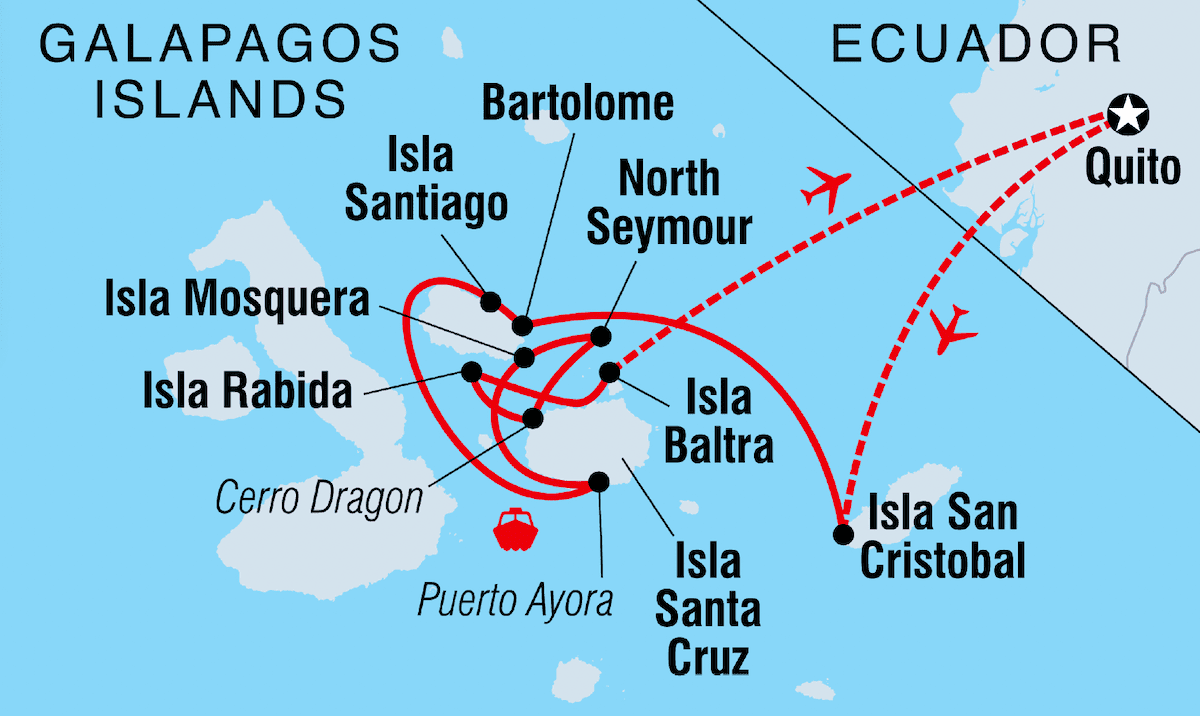
Our itinerary around the Galápagos with Intrepid Travel on a small ship/ Photo by Intrepid
As a guest of Intrepid Travel, I’m on a 12-day trip called the “Galapagos Classic” with about 18 other passengers. This small ship expedition focuses on the Central Eastern islands, starting on San Cristobal with stops at Isla Santiago, Bartolome, North Seymour, Isla Mosquera, Isla Rabida and Isla Baltra, where I depart back to Quito. At each island, accompanied by a Galápagos National Park Services Guide, our small group witnesses some of the world’s most spectacular wildlife and natural phenomena. From my first sighting of a blue footed booby on the volcanic rocks to magnificent frigates flying overhead and white-tipped sharks lounging underwater, I am enthralled by this magical place.
On my first-ever zodiac excursion, I see a family of penguins hopping into the water, blue-footed boobies and walking on volcanic rock that’s millions of years old. The backdrop for my first snorkelling experience in Bartholomew is the Pinnacle Rock, one of the most photographed sites in the Galápagos – a rock structure protruding from the earth. The moment I jump into the water, a green turtle swims past, alongside walls of fish and white-tipped sharks on the ocean floor. On the beaches, juvenile sea lions play just a few feet away from me, frolicking like children on the shore.

Sunset in the Galapagos Islands / Photo by Carolyn Ray
The Galápagos National Park Service
Ninety-five percent of the land area of Galápagos is designated as protected by the Galapagos National Park Directorate (GNPD), and tourists are permitted to explore specific visitor sites only with Park-certified naturalist guides.
I’m in the Galápagos in August, during the cool/dry season (July through December) and the weather is balmy during the day and cool at night. During the hot/rainy season (from January to June) it rains most afternoons. The “peak season” is sometimes described as mid-June through early September and from mid-December through mid-January. In 2022, almost 270,000 tourists visited the Galápagos Islands, close to the pre-Covid levels of 2019. Most of this growth is land-based visitation, which carries even larger risks of introduction and dispersal of alien species compared with ship-based tourism.
My Intrepid National Park Services guide, Roberto King, is a passionate evangelist for the conservation, biodiversity and eco-diversity of this very special group of islands. Once a science teacher and high school principal in Puerto Ayora, before he became a naturalist guide, he gives us our first lesson in conservation: no touching, no flash photography and no going off-trail.
“We are fighting between development and conservation,” says King. “To be a good tourist, follow the rules and enjoy it. We have these very good people coming who are interested in asking questions, watching everything, and enjoying. They accept that we have regulations that we need to protect the Galapagos. These regulations aren’t something ugly – it is our personal obligation to follow the rules and protect animals.”
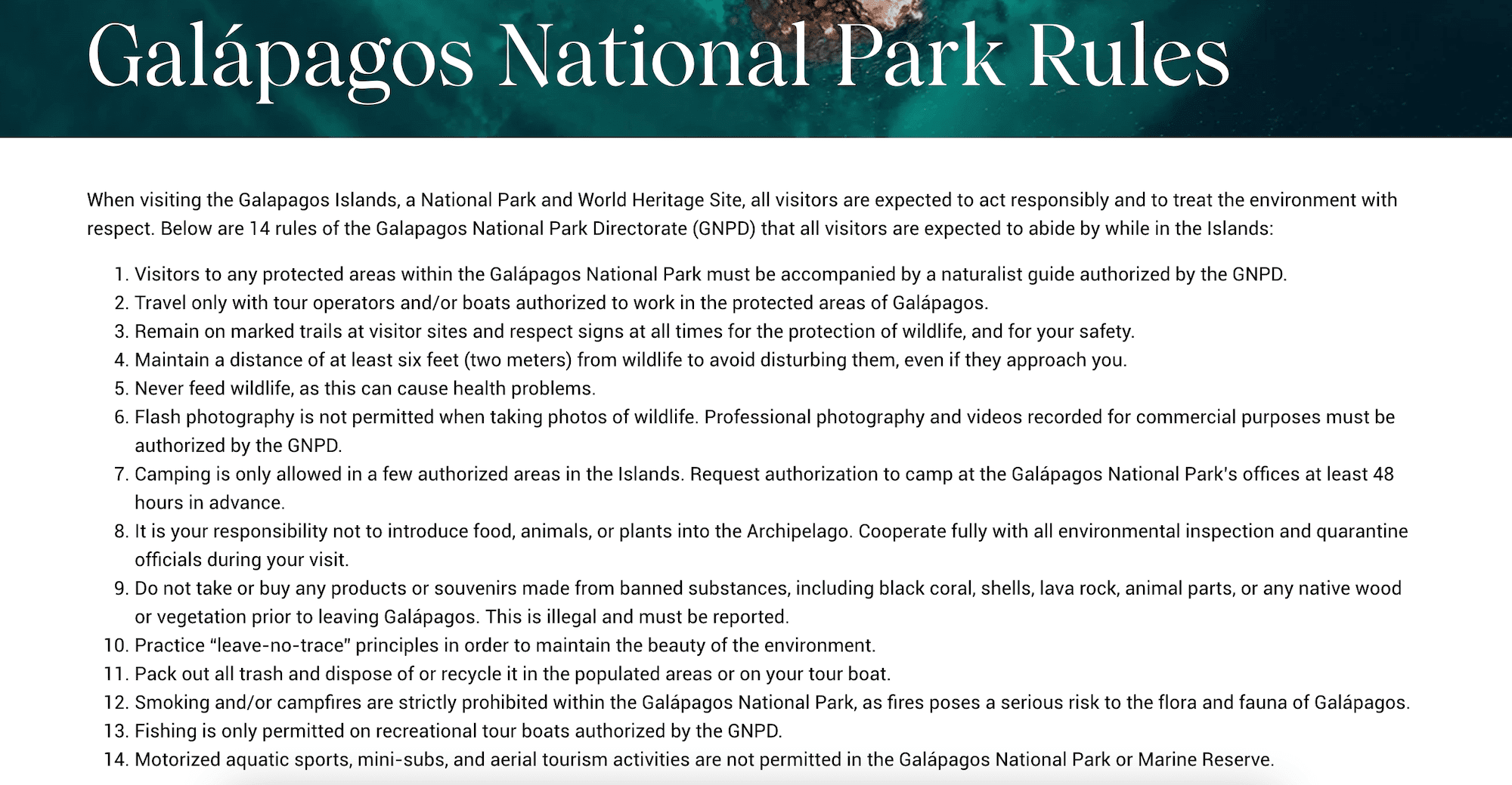
Galapagos National Park Service Rules / Source: Galapagos.org
The Charles Darwin Research Station and Lonesome George
Founded in 1959, the Charles Darwin Foundation for the Galápagos Islands is an international non-profit organization dedicated to scientific research for the conservation of the environment and biodiversity of the Galapagos archipelago. With 100 scientists, educators, research assistants, support staff and volunteers, the organization’s staff is composed by more than 75% Ecuadorians and also provides scientific knowledge and technical advice to the Government of Ecuador to ensure the conservation of Galapagos.
In 1971, years after the last three Pinta Tortoises were given to museums, Lonesome George was found on Pinta Island. He was brought to the Darwin Research Station on Santa Cruz Island for protection, with the hopes that he would be able to mate with a female and continue his line.
However, after years of unsuccessful efforts, George died from a heart attack, becoming the last of the Pinta Island tortoises. Not only he is memorialized on the badges worn by Galapagos Park Staff, Lonesome George’s body is preserved in a special building at the Darwin Research Station for all to see, a constant reminder of extinction.
Threats to the Galapagos Islands
The Galapagos is a place where there are often more questions than answers. King has a wonderful expression for this – “nada es verdad ni es mentira todo depende del cristal con que se mira” which means everything can be true — or not. It all depends on your perspective. With every new question there seems to be another one that arises.
El Nino, which recurs every seven to 13 years, is a threat this year. With winds producing warmer temperatures, it is expected to profoundly affect sea lions and iguanas in particular. Marine iguanas, which have already adapted to swim and digest green seaweed, are at risk if warmer waters kill their primary food source. Non-endemic species, like rats, cats, goats and other creatures, have had to be removed from the islands.
Another challenge is managing invasive species that threaten endemic species. For example, scientists are attempting to save the mangrove finch, which is near extinction with only 100 in existence. However, the mangrove finch is attacked by an invasive fly that lays eggs in its nest. So far, the fly is resistant to insect repellent.
For companies that operate in the Galapagos like Intrepid Travel, sustainable travel is a priority. Not only does Intrepid operate a small ship, it also supports the Galapagos Conservancy, the only U.S.-based non-profit dedicated exclusively to the protection and restoration of the Galápagos Islands.
Regulating tourism in the Galapagos
Calls to regulate land-based tourism came after UNESCO released a report outlining a rapid increase in visitors to the Galapagos in 10 years, which contradicts the earlier goal of zero-growth tourism. In the UNESCO report, experts note that significant steps are being made toward effective long-term monitoring and adaptive management, but that “longstanding and emerging threats including invasive alien species (IAS), tourism and associated infrastructure, illegal harvesting of natural resources, climate change and land conversion remain stable and require ongoing management efforts.”
The reported opening of a new flight connection to the Galapagos from the city of Manta in Ecuador in March 2023 is also anticpated to create an increase in tourists. But there are controls in place. In addition to limiting ship size, for more than two decades, Ecuador has only allowed small ships with less than 100 passengers. In addition, there a fee of US $120 for non-Ecuadorian visitors to obtain a Transit Pass ($20 on departure and $100 upon arrival). Ecuadorians pay US $6.
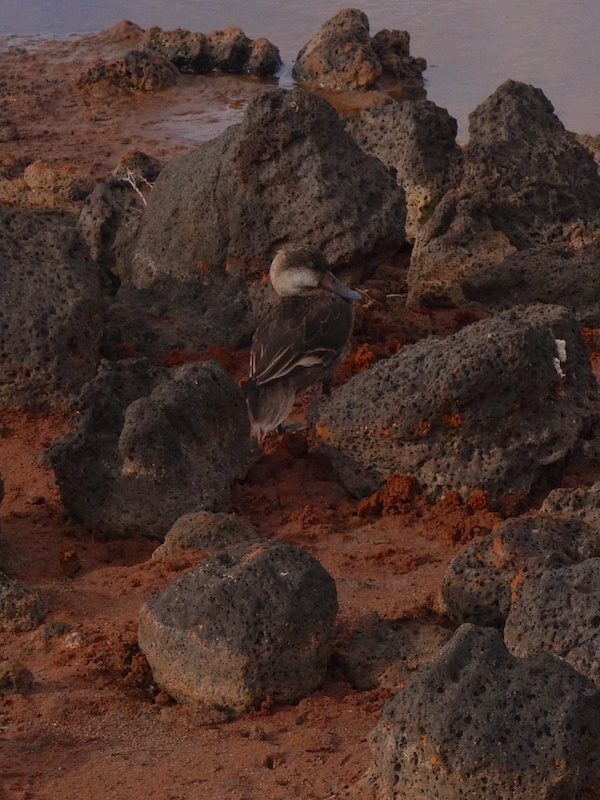
A baby blue footed booby blends into the rocks / Photo by Carolyn Ray
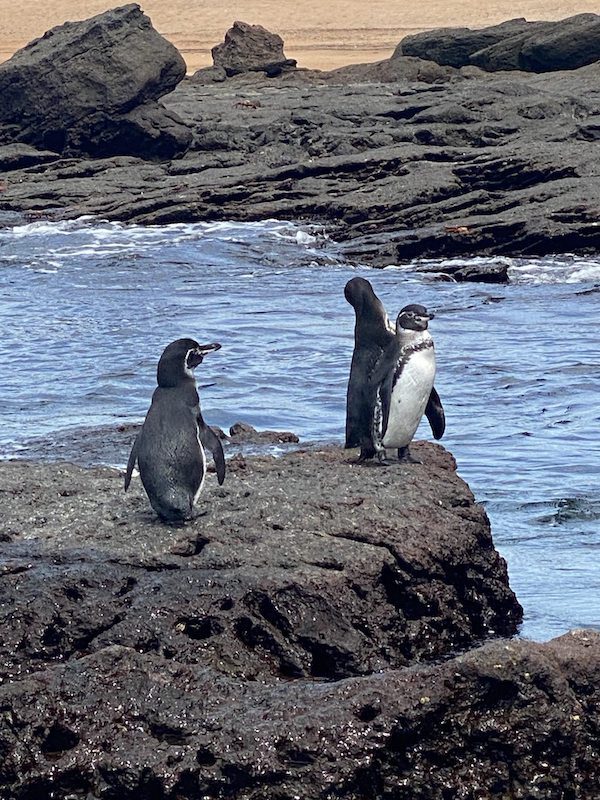
Galapagos Penguins! / Photo by Carolyn Ray
How we can be good tourists
Travelling on a small ship with Intrepid is evidence of the intentional and conscious desire that I witnessed to protect wildlife in the Galapagos. This starts with no plastic bags and bottles, and ends with putting toilet paper in the garbage, a habit I take home with me.
Since the Galapagos National Park Service works with tour providers to coordinate every ship’s itinerary and has restrictions on the number of visitors to each island at any one time, it doesn’t feel overcrowded.
According to Matt Berna, President, The Americas, Intrepid Travel, the solution is not more or less tourism; the solution is better tourism.
“No matter where you travel, there are concerns about how tourism can impact the destination, whether that impact is overwhelming local businesses in a small port town, wearing away at hiking trails or damaging the natural environment,” says Berna.
Ivonne Torres, Coordinator at the Galapagos Conservancy in Santa Cruz, says one way people can be good tourists is to embrace slow travel and spend more time on the islands.
“Spend some time on the boats and then some time on the island,” says Torres. “That helps you be part of the culture, the community in a town. You don’t have to be in three places on the same day. Be a slow tourist and absorb it all.”
One of the main projects of the Galapagos Conservancy is to educate Ecuadorians, who make up the majority of tourists, about conservation. Recently, it has embarked on a 10-year program funded by Goldman Sachs to educate schoolchildren about sustainability. With one-third of the Ecuadorian population under age 25, the premise is that the kids will educate their parents. It’s in year seven, and the curriculum is embedded in all courses on everything from electricity to waste.
Torres says they’re also looking for teachers. “With English, we’re trying to create a program where foreign teachers can teach ESL to local kids,” she says. “ At some point perhaps they’re going to go into tourism, so they will need the skills.”
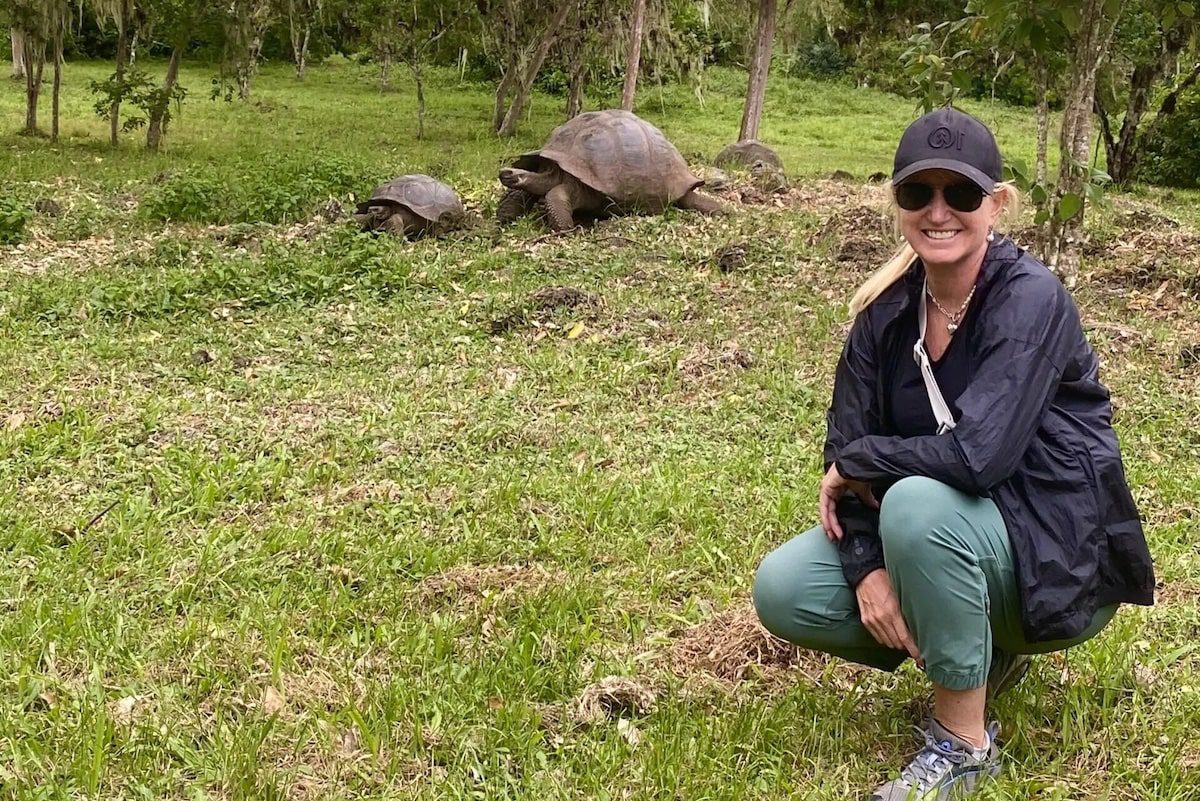
Visiting a tortoise reserve in the Galapagos / Photo by Carolyn Ray
“There is a moral dilemma with travel and Intrepid must walk the fine line between promoting must-see destinations and helping to protect an irreplaceable landmark or ecosystem,” says Intrepid’s Berna. “This concern is perhaps most apparent in the Galapagos Islands. Tourism to this fragile ecosystem has more than quadrupled in the last 20 years (and the local population has doubled), which means the islands have been hit with unprecedented amounts of human interference.”
However, Berna believes that tourism can have a positive impact on the area as well.
“Experts agree that tourism dollars have helped fund conservation efforts in the Galapagos,” he says. “And what is perhaps almost as valuable is the perspective travelers gain after visiting the islands for themselves. It’s hard to understand how small things can have a huge impact on an ecosystem until you’ve experienced that delicate balance for yourself.”
How to get to the Galapagos Islands
I flew from Toronto to Miami on Air Canada, and then Miami to Quito on American Airlines. If you need to recover from jet lag, there are several hotels near the airport, including a Holiday Inn Express. Most flights to the Galapagos leave early in the morning, so there’s no point in going into Quito, which is about 45 minutes. You can also fly from Guayaquil on the coast (in fact, our flight had a stopover there). Check flight prices here.
However, if you go on an organized trip, it may include a night at a hotel. Before and after the trip, I stayed at Le Parc, a small, quiet hotel in the north part of Quito, which also included breakfast.
Travel with licensed operators
Travel is only permitted with tour operators and/or boats authorized to work in the protected areas of the Galapagos. My boat, the Queen Beatriz, had capacity for 18 passengers, which was just the right size for conversation and connection.
Most of the time, we were on our own, but in the larger ports, I observed larger boats while I was there, including Silversea and Celebrity Cruises, which is owned by Royal Caribbean. The Galapagos Conservancy has a list of sustainable travel partners here.
Where to stay
For longer trips on the islands, there are many hostels and small hotels. (Do you have a suggestion? Share in our Places to Stay Directory.)
What to pack for a trip to the Galapagos
There are weight restrictions on baggage to the Galapagos and you don’t need to bring much. I travelled with one small carry-on and a backpack. Your checked and carry-on bags can have no more than a combined weight of 44 pounds, and the carry-on bag may weigh no more than about 17 pounds and must fit under the seat in front of you or in an overhead compartment. My hotel in Quito stored my other belongings.
US Cash: Ecuador uses US currency, and you’ll need some on hand for any purchases and tipping. It’s recommended to tip guides between $8-10 per day and the crew $5 per day, per person. You’ll also need cash for a Transit pass, which is $120 USD for non-Ecuadorian visitors, whereas Ecuadorians pay $6.
Hiking and Walking Shoes: There are no shoes on board the boat, which simplifies things! For the trip, however, you’ll want to have water sandals like these Tevas for water landings. Definitely bring hiking shoes (I prefer Merrell) or running shoes with tread. Flip-flops and water shoes are nice to have but not necessary. I only wore my flip-flops because I didn’t have water sandals, which I would have preferred.
Folding hiking poles: The volcanic rocks and stairs can be slippery, and there are hills. While canes were available on the boat, bring hiking poles for the islands, such as these ones from the Trekology brand.
Sun protection clothes: Consider UPF protective clothing. I wore my Body Glove shirt all the time, a Coolibar sun coverup and a Tilley sun protective hat.
Sunglasses: I like my brand of SunDog sunglasses because they’re lightweight and replaceable.
Waterproof camera: One of my regrets is that I couldn’t film the underwater adventures – astonishing arrays of fish, small sharks and turtles. With over 650 species of fish in the Galapagos, a Go-Pro camera would have been heaven. Don’t forget a portable charger like this Anker brand or a spare battery.
Binoculars: My Occer 12×25 Compact Binoculars were the perfect size for this trip.
Dry bag: Several other women had dry bags to protect their phones and cameras on the Zodiac. They recommend the Sea to Summit bags here.
Seasickness pills: We only had one rough day and night and a few on board had a rough time. Bring pills or a Relief Band if you are concerned.
Medicine, Menstrual supplies, Medication, Contact lenses and cleaning solution: Don’t forget to pack these, finding them anywhere will be a challenge.
Disclaimer: For this trip, I was a guest of Intrepid Travel on its 12-day Galapagos Classic Tour, however Intrepid did not review this article before it was published. As a member of our Small Ships Directory, Intrepid also offers several other itineraries and discounts for JourneyWoman readers here. Sign up now to get special deals and discounts here.
More to Discover From South America
JourneyWoman Webinar: Less-Travelled South America on June 25
Join our June 25 webinar to learn more about lesser known places in South America from experts in our JourneyWoman Women’s Travel Directory.
Hotels We’d Travel the World For, Just to Stay Again
Travel around the world with women-recommended places to stay that will take you to boutique hotels, guesthouses, retreats and more!
30 Less-Travelled Places for Women in 2024
For our 30th anniversary, JourneyWoman reveals 30 less-travelled places for women in 2024, according to our writers and travel experts.

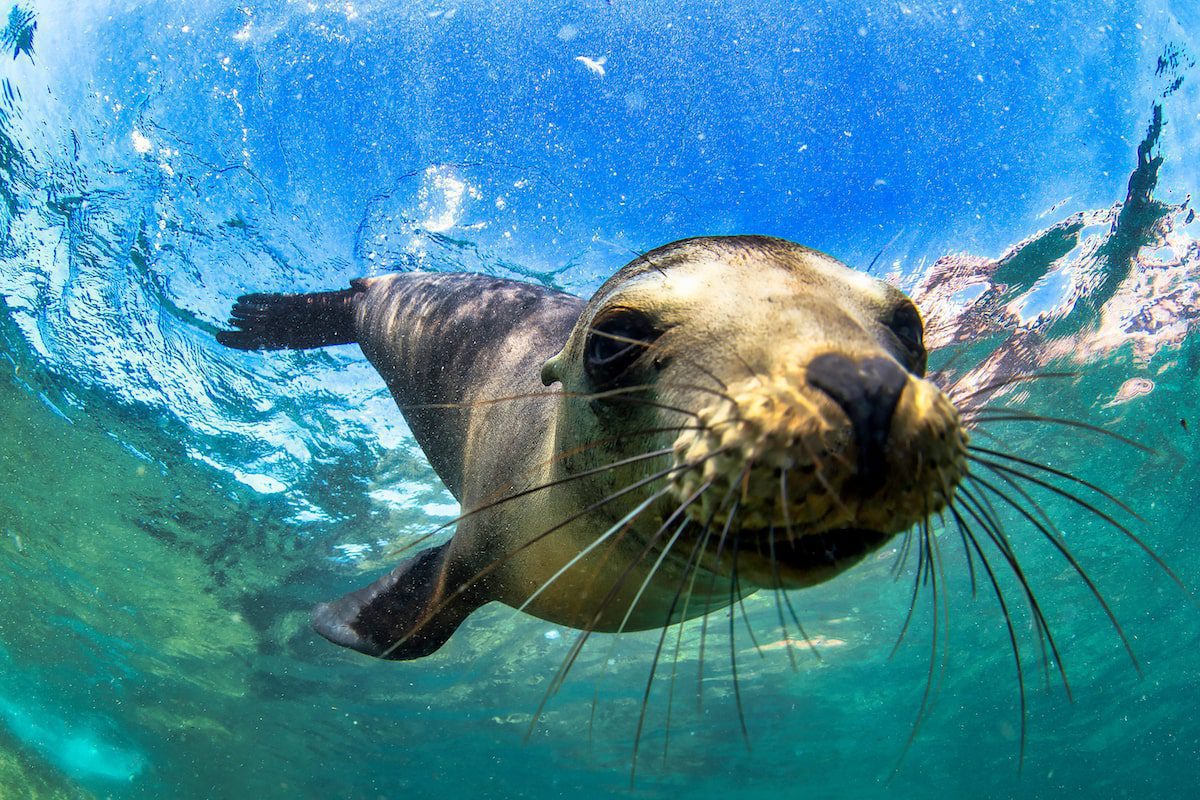




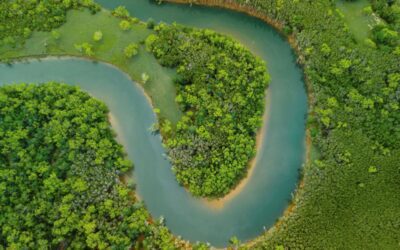


0 Comments
We always strive to use real photos from our own adventures, provided by the guest writer or from our personal travels. However, in some cases, due to photo quality, we must use stock photography. If you have any questions about the photography please let us know.
Disclaimer: We are so happy that you are checking out this page right now! We only recommend things that are suggested by our community, or through our own experience, that we believe will be helpful and practical for you. Some of our pages contain links, which means we’re part of an affiliate program for the product being mentioned. Should you decide to purchase a product using a link from on our site, JourneyWoman may earn a small commission from the retailer, which helps us maintain our beautiful website. JourneyWoman is an Amazon Associate and earns from qualifying purchases. Thank you!
We want to hear what you think about this article, and we welcome any updates or changes to improve it. You can comment below, or send an email to us at [email protected].